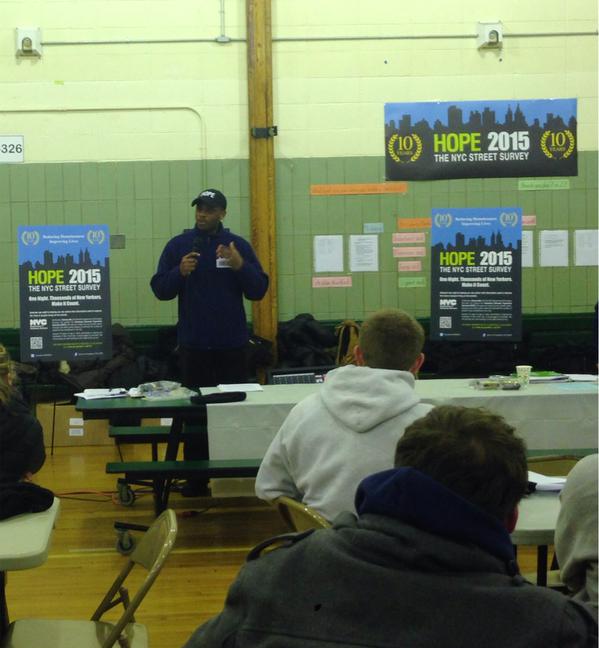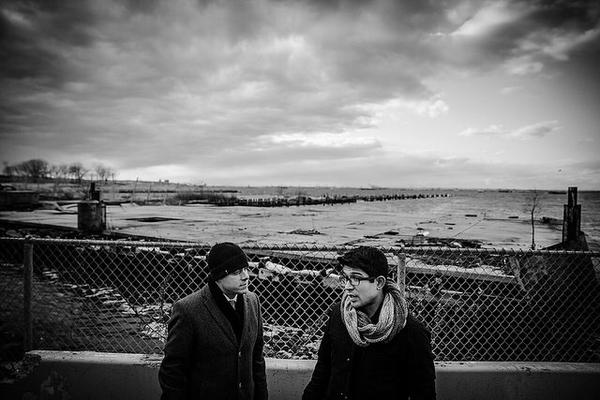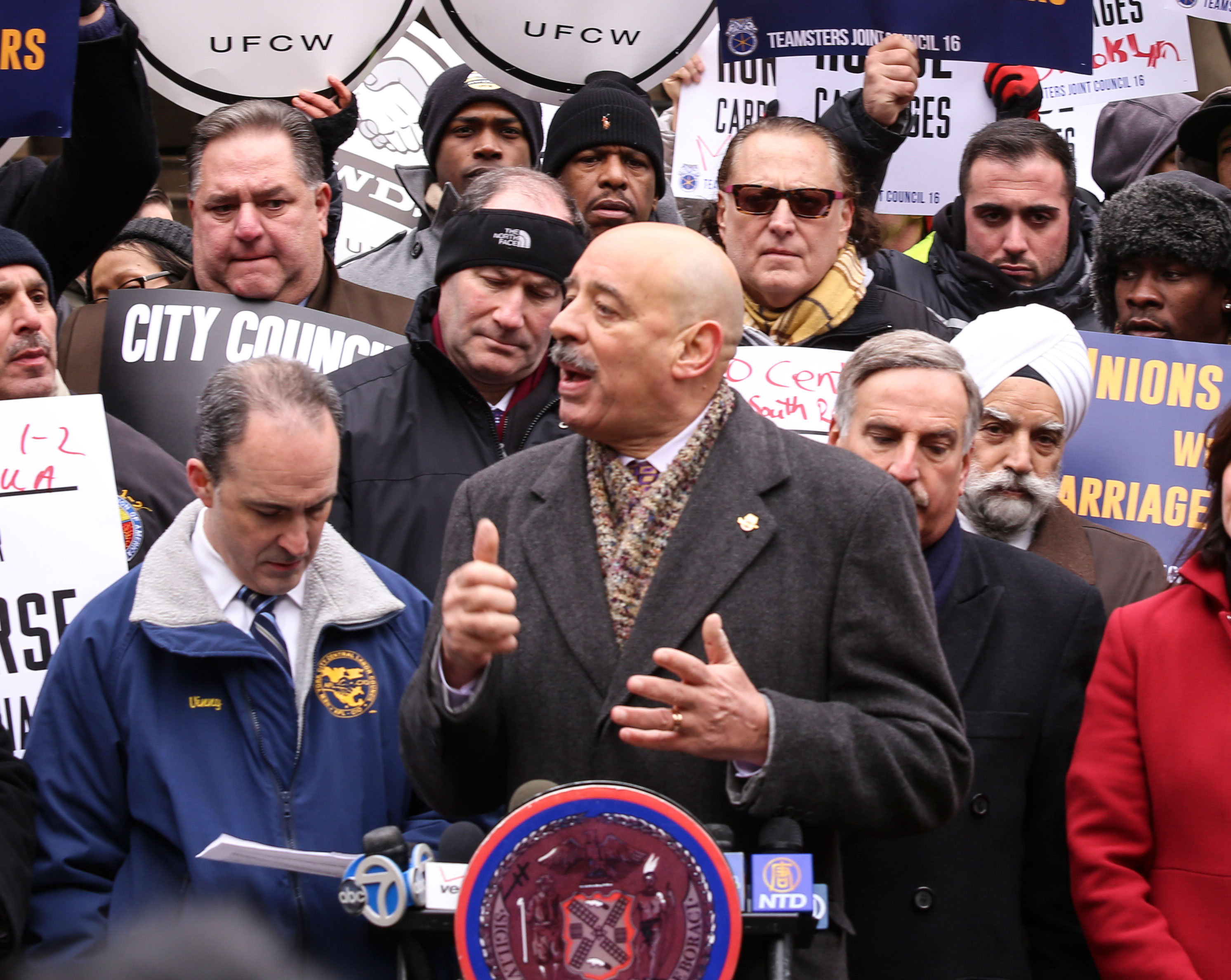This Budget, Let's Make HOPE Truly Count

DHS Commissioner Taylor during HOPE 2015 (photo: @JennsLenz)
Last Monday night, thousands of volunteers spanned across New York City to conduct Homeless Outreach Prevention Estimate (HOPE) 2015. HOPE is the annual point-in-time count of the New York City street homeless. It enables the City to gauge the extent of street homeless in New York City – an estimated 3,357 individuals last year. HOPE also helps the City to evaluate the ongoing street homelessness work it and its nonprofit partners are doing, including outreach.
Outreach work has two components. First, workers attempt to engage the street homeless individual, who is often living with a mental illness, substance abuse issue, or severe health problem.
"You introduce yourself, give them your card and ask them if there's anything they need," says Hilton Douglas, an Urban Pathways outreach worker. "Sometimes they tell us to get out of their face, but you just have to keep engaging with them day in and day out. Other times you catch them at the right time and with the right tone, and they open up."
On day one of Port Authority Bus Terminal outreach work this past September, Urban Pathways staff engaged Mark H. His body was covered with open sores, including some on his left leg infested with maggots. When outreach approached him, he insisted he did not need help. After outreach workers found him 24 hours later, he agreed to go to the Olivieri Drop-In Center where he got a shower and new clothes and met with a nurse. He also agreed to go to the hospital where he was diagnosed as a paranoid schizophrenic.
The second important component of outreach work is placement. For Mark H, placement was a return home to his family. After initial assessment, Olivieri staff discovered he was the subject of a six-month, Ohio missing person report. Once staff contacted the local Ohio sheriff office and Mark H was stabilized, his brother came and took him home.
The placement that occurred for Mark H is infrequent though. More often, street homeless individuals are placed in drop-in centers or city single adult shelters. There, with the invaluable assistance of case managers, they stabilize and work to become housing-ready and move along the path to self-sufficiency and permanent housing.
However, many homeless adults living on the streets are unwilling to enter the city shelter system. They fear they will be victimized. Or, they may be seriously impaired due to mental illness or substance abuse and unable to commit to treatment or recovery as a condition to accessing shelter. For this chronically homeless population, the City offers safe havens, which operate using the housing first model – an approach that centers on providing the homeless with housing as quickly as possible and then providing services as needed.
Safe havens constitute a particularly viable placement option. Beside providing shelter and services, they allow for a transitional period to begin the rehabilitative process and recovery from the harshness of the streets. New York City has recognized the utility of safe havens. There are ten in four boroughs - three in the Bronx, four in Manhattan, two in Brooklyn, and one on Staten Island.
Another key service model in addressing street homelessness is supportive housing - affordable housing combined with support services tailored to individual needs. Supportive housing has proved effective. In the first five years of the most recent New York City/State supportive housing agreement, New York City chronic homelessness decreased by almost half. The utility of supportive housing, in part, stems from the stabilization it provides to those who have lived extremely unstable lives. However, there is a dearth of supportive housing in New York City. Only one supportive housing unit is available for every six eligible individuals. At least two-thirds of New York City street homeless are in need of permanent supportive housing.
As the City and State move forward in budget season, let's make HOPE truly count by adequately investing in these placement options. It is encouraging that the City will devote more resources to unsheltered homeless people this year, allocating more than $45 million in City and State funds, up from $35.5 million the year before. It is less than encouraging that the City and State have not adopted a new City/State supportive housing agreement. In particular, we call on the State, notably Governor Cuomo, to amend the proposed state budget and fully fund the State's share of a New York City/State supportive housing agreement. The time is now to account for and support all those counted during this year's HOPE and those before.
***
by Nicole Bramstedt and Erik Ipsen
Bramstedt is the Policy Analyst at Urban Pathways.
Ipsen is a member of the Board of Urban Pathways, where he has served since 2002.
***
Have an op-ed idea or submission for Gotham Gazette? E-mail editor Ben Max: This email address is being protected from spambots. You need JavaScript enabled to view it.
Moving Forward in Sunset Park

CMs Garodnick, left, and Menchaca visit the site in question (photo: William Alatriste)
Mayor Bill de Blasio's mantra around addressing the "Tale of Two Cities" that is New York particularly resonates in Sunset Park, Brooklyn. It is one of the city's few remaining industrial waterfront neighborhoods with a high concentration of working-class and poor residents, mostly immigrants from Asia and Latin America. However, the growing presence of the creative class including fashion designers and artisanal manufacturers has stirred concerns of gentrification and displacement among long-time residents and community stakeholders.
Make no mistake, Sunset Park is at a crossroads. The industrial waterfront is changing through private and public investment after long years of neglect. But if the tale of two cities is to be truly tackled, the waterfront's renaissance needs to be inclusive.
Measures must be taken to ensure that long-time residents and businesses are not forced out due to rising property values triggered by the introduction of affluent millennials as Sunset Park entrepreneurs and residents. The de Blasio Administration must recognize that creating jobs with living wages is as essential as affordable housing.
Toward that end, it might be instructive for the administration to revisit the de Blasio mayoral campaign's ideas. Mayor de Blasio was one of the few candidates to specifically articulate an industrial attraction and retention policy, doing so in a paper titled, "A Progressive Vision for Industrial Development in New York City."
Recognizing the need for blue-collar jobs and manufacturing's high annual wages in comparison to the retail or food service industries (two of the city's fastest growing job sectors), candidate de Blasio pointed to the Brooklyn Navy Yard and the Greenpoint Manufacturing Design Center as "models for non-profit industrial development" that create good jobs. In the same paper, he specifically proposed that Sunset Park's Brooklyn Army Terminal and Bush Terminal - two massive industrial sites managed by the New York City Economic Development Corporation (EDC) - "would benefit from an independent non-profit manager dedicated to strategic investment, workforce development, and reinvestment into the target area." [italics added]
Sunset Park City Council Member Carlos Menchaca seems to have read the same policy paper when he proposed the formation of such a non-profit entity to act as a steward for the South Brooklyn Marine Terminal (SBMT) rather than signing away control of the 70-plus-acre site to the EDC for the next half-century.
EDC's chief, a mayoral appointee, called off the deal claiming "it's not good public policy" in the New York Daily News and described the proposal as "confounding" in Crain's New York.
We're puzzled by the EDC's actions. We grew up in Sunset Park and our father continues to live in the same house he's called home since 1974. Both of our parents labored in industrial, manufacturing jobs. We wholeheartedly support Mayor de Blasio's commitment to ensuring that the same opportunities our family had remain available for all New Yorkers.
In his State of the City speech, Mayor de Blasio stated that "[c]reating more affordable housing; raising wages and benefits; strengthening our neighborhoods by better connecting them to jobs and opportunity—that is how we'll take on the Tale of Two Cities." Now is the time to move this vision forward and candidate de Blasio proposed a way to do so in Sunset Park.
***
by Tarry and Carl Hum
Tarry Hum is a professor at the City University of New York and author of Making a Global Immigrant Neighborhood: Brooklyn's Sunset Park
Carl Hum is a civil rights attorney in Washington D.C. and former director of the New York City Mayor's Office of Industrial and Manufacturing Businesses
***
Have an op-ed idea or submission for Gotham Gazette? E-mail editor Ben Max: This email address is being protected from spambots. You need JavaScript enabled to view it.
Labor Supports a Fair Trash Plan

George Miranda, the author, at a rally (photo via International Brotherhood of Teamsters)
There are few things more political in New York City than garbage.
On Friday, the City Council's Sanitation Committee held a hearing on Intro. 495, legislation that will cap the amount of trash that can be sent to any one neighborhood for disposal.
It sounds simple enough and only fair. But fights between communities and big corporations, who make a lot of money hauling garbage, are rarely easy. Intro. 495 is a different story. Labor is standing shoulder-to-shoulder with these communities and holding the companies where our members work accountable.
The Teamsters are New York City's sanitation union. From the Department of Sanitation workers who pick up the trash and recycling from your home, to the private carting workers who collect and process waste from New York City businesses, we take out the trash.
In the past, unions did not see community activists as our allies – or worse, we saw them as Not-In-My-Backyarders standing in the way of jobs. I now know that these fights are our fights too. Caring about workers does not end when they clock out. If our members do not have clear air to breathe or safe streets to walk with their kids, that is a union issue.
It is also about fundamental fairness. Forcing a few neighborhoods to take almost all of the city's trash is just plain wrong.
Currently, three-quarters of New York City's trash is sent to three communities: the South Bronx, North Brooklyn, and Southeast Queens. Almost half of our city's trash comes from Manhattan, but the borough lacks a single transfer station, the facilities where garbage is dumped every day and loaded onto trucks destined for out-of-state landfills.
The Department of Sanitation plans to change that with a state-of-the-art transfer station on East 91st Street, and others around the city. Technology will control odors and pollution, and trash will be exported by barge and rail, reducing the number of trucks on our streets. The employees will join the ranks of the city's sanitation workers, Teamster members who receive good pay, benefits, and safety protections.
The South Bronx, where I grew up, is home to numerous dirty, old waste transfer stations. Every morning, long lines of private garbage trucks form in front of homes, schools, and parks, waiting to drop off their loads. The smell is even worse than the sight – garbage fumes and diesel exhaust – and the problem is more than aesthetic. Children in these communities have higher asthma rates than the city as a whole because of pollution like diesel exhaust.
It's not a coincidence that neighborhoods like the South Bronx get saddled with all of our waste. The sanitation corporations have always found it easier to operate in poor communities of color. Our city government has gone along with it.
Mayor de Blasio and the City Council can do better. Voters want elected officials who will make sure the trash gets picked up, but we also voted for a vision of one city, where the poorest and most vulnerable among us are protected.
Intro. 495 would do two things. It would reduce the amount of trash going to the three most burdened neighborhoods. They would still take more trash than anywhere else, but the impact would be lessened. This has been the goal of opening a fleet of modern transfer stations, which will soon come on line around the city, but this legislation would make it the law too.
Second, the legislation would create a cap for all communities, so that no neighborhood ever again takes more than its fair share of trash.
Intro. 495 is part of a larger movement to make a waste system that works for everyone. At the same time, we are working to increase recycling, expand composting, and raise working standards in the sanitation industry.
You might be asking yourself, why would the sanitation workers union want to reduce the amount of trash we collect? The truth is, this is an industry where becoming more efficient actually creates more and better jobs. Recycling creates five to 20 times more jobs than landfilling trash. By increasing recycling we won't just be cleaning up our communities, we will also be creating good jobs for New York families.
Less trash is better for New Yorkers, at home and at work.
***
George Miranda is President of Teamsters Joint Council 16.
***
Have an op-ed idea or submission for Gotham Gazette? E-mail editor Ben Max: This email address is being protected from spambots. You need JavaScript enabled to view it.




